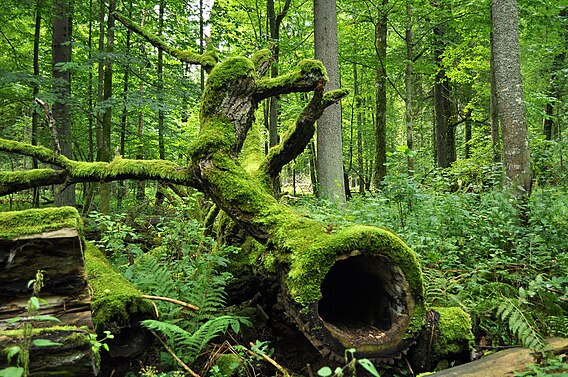 One of to last intact forests of Europe is under threat. Białowieża is the only lowland primeval forest in Europe. It boasts Europe’s tallest trees and largest wild mammal, the bison. Only a small portion (16%) is a national park and parts are protected by the EU and as a Unesco world heritage site. The rest is gazetted as “commercial forest”. However, in the past years, environmentalist won the battle to put logging under control: local communities were permitted to harvest 48,000 cubic metres of timber each year and the government is to allow at least 180,000 cubic metres. The new environment minister, Jan Szyszk decided to open the forest to commercial logging, claiming that the forest is “rotting away” because spruce trees are being killed by the spruce bark beetle. The battle however is not about the rotting spruces, but about the ancient trees - those are not affected by the bark beetle. And the scientists exposed the “scientific” claims of the Polish government: “If we allow it to become a managed forest, its value and its biodiversity will be lost. says to The Guardianpol Rafał Kowalczyk, director of the Mammal Research Institute inside Białowieża “It will take hundreds of years to reverse this kind of destruction.”
One of to last intact forests of Europe is under threat. Białowieża is the only lowland primeval forest in Europe. It boasts Europe’s tallest trees and largest wild mammal, the bison. Only a small portion (16%) is a national park and parts are protected by the EU and as a Unesco world heritage site. The rest is gazetted as “commercial forest”. However, in the past years, environmentalist won the battle to put logging under control: local communities were permitted to harvest 48,000 cubic metres of timber each year and the government is to allow at least 180,000 cubic metres. The new environment minister, Jan Szyszk decided to open the forest to commercial logging, claiming that the forest is “rotting away” because spruce trees are being killed by the spruce bark beetle. The battle however is not about the rotting spruces, but about the ancient trees - those are not affected by the bark beetle. And the scientists exposed the “scientific” claims of the Polish government: “If we allow it to become a managed forest, its value and its biodiversity will be lost. says to The Guardianpol Rafał Kowalczyk, director of the Mammal Research Institute inside Białowieża “It will take hundreds of years to reverse this kind of destruction.”As Kowalczyk explains, the shallow-rooted spruce is suffering because of drier soils and climate change. Its destruction by the beetle is a natural process that creates a more resilient forest: in areas where spruce does not regenerate, it will be quickly replaced by species – such as hornbeam and lime – better suited to these environmental conditions. It is natural for healthy forests to have plenty of dead wood, supporting huge numbers of invertebrates and other animals. The three-toed woodpecker is four times rarer in the commercially harvested part of Białowieża.
Tracts of the forest are unique because they have never been felled, but the forest is not completely “primeval”. It supports an indigenous human population that derives its livelihood from tourism, honey, mushrooms, hunting or timber and the Polish government’s case for destruction mixes cultural warfare with a dishonestly selective use of science. It claims the heritage of local people who traditionally make use of the forest’s riches is trampled upon by international conservation. But, while international scientists have spoken out against the logging, as has WWF and Greenpeace Poland, the strongest defence of the forest has been mounted by local scientists and local charities.
They say the beetle is a handy alibi for commerce. Before Szyszko (a forestry teacher) was elected, he spoke of the wasted commercial potential of unlogged wood. Only 57% of the proposed harvest refers to disease-ridden spruce – its rotten wood is worthless. Loggers want to get their hands on valuable, large old trees. One forest district has already almost felled an allowance of trees which was supposed to last until 2021 and so the government will permit it to increase its annual take from 6,000 cubic metres to 53,000 cubic metres. Other districts are likely to follow suit.
The richness of Białowieża lies in its untouched status and size. Hack away at the edges, reduce the forest to managed fragments, and scientists warn that unique species and features of this complex ecosystem will be lost. Białowieża needs more protection, not less: its national park is 100 sq km but a lynx’s territory can stretch across 300 sq km.


